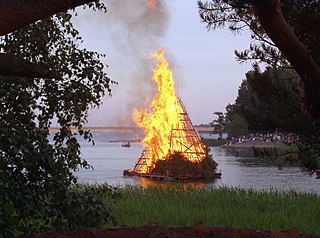Midsummer is a celebration to mark the time around the summer solstice.
Contents
Midsummer or Midsummer Night may also refer to:
Midsummer is a celebration to mark the time around the summer solstice.
Midsummer or Midsummer Night may also refer to:
Summer solstice is the astronomical phenomenon that occurs on the longest day of the year.

The Wheel of the Year is an annual cycle of seasonal festivals, observed by a range of modern pagans, marking the year's chief solar events and the midpoints between them. British neopagans Gerald Gardner and Ross Nichols crafted the Wheel of the Year in the mid-20th century, combining the four solar events marked by many European peoples, with the four seasonal festivals celebrated by Insular Celtic peoples. Different paths of modern Paganism may vary regarding the precise timing of each celebration, based on such distinctions as the lunar phase and geographic hemisphere.

A bonfire is a large and controlled outdoor fire, used either for informal disposal of burnable waste material or as part of a celebration.

Midsummer is a celebration of the season of summer, taking place on or near the date of the summer solstice in the Northern Hemisphere; the longest day of the year. The name "midsummer" mainly refers to summer solstice festivals of European origin, especially those in the Nordic countries. In these cultures it is traditionally regarded as the middle of summer, with the season beginning on May Day. Although the summer solstice falls on 20, 21 or 22 June in the Northern Hemisphere, it was traditionally reckoned to fall on 23–24 June in much of Europe. In Christian tradition, these dates coincide with Saint John's Eve and Saint John's Day. It is usually celebrated with outdoor gatherings that include bonfires and feasting.

Saint John's Eve, starting at sunset on 23 June, is the eve of the feast day of Saint John the Baptist. This is one of the very few feast days marking a saint's birth, rather than their death. The Gospel of Luke states that John was born six months before Jesus; therefore, the feast of John the Baptist was fixed on 24 June, six months before Christmas. In the Roman calendar, 24 June was the date of the summer solstice, and Saint John's Eve is closely associated with Midsummer festivities in Europe. Traditions are similar to those of May Day and include bonfires, feasting, processions, church services, and gathering wild plants.
Scream may refer to:
Winter is one of the four temperate seasons.
Splash or Splash! or The Splash may refer to:

Sânziană is the Romanian name for gentle fairies who play an important part in local folklore, also used to designate the Galium verum or Cruciata laevipes flowers. Under the plural form Sânziene, the word designates an annual festival in the fairies' honor. Etymologically, the name comes from the Latin Sancta Diana, the Roman goddess of the hunt and moon, also celebrated in Roman Dacia. Diana was known to be the virgin goddess and looked after virgins and women. She was one of the three maiden goddesses, Diana, Minerva and Vesta, who swore never to marry.
Celebration or Celebrations may refer to:
Haunted or The Haunted may refer to:
Equinox commonly refers to:
The Lovers is a trump or "Major Arcana" tarot card.
Day of the Dead is a holiday celebrated in Mexico and elsewhere on October 28 through November 3.

The winter solstice, also called the hibernal solstice, occurs when either of Earth's poles reaches its maximum tilt away from the Sun. This happens twice yearly, once in each hemisphere. For that hemisphere, the winter solstice is the day with the shortest period of daylight and longest night of the year, and when the Sun is at its lowest daily maximum elevation in the sky. Each polar region experiences continuous darkness or twilight around its winter solstice. The opposite event is the summer solstice.

The summer solstice or estival solstice occurs when one of Earth's poles has its maximum tilt toward the Sun. It happens twice yearly, once in each hemisphere. For that hemisphere, the summer solstice is the day with the longest period of daylight and shortest night of the year, when the Sun is at its highest position in the sky. At either pole there is continuous daylight at the time of its summer solstice. The opposite event is the winter solstice.

Yaldā Night or Chelle Night is an ancient festival in Iran, Afghanistan, Azerbaijan, Tajikistan, Iraqi Kurdistan, Uzbekistan, Turkmenistan, Dagestan and Turkey that is celebrated on the winter solstice. This corresponds to the night of December 20/21 (±1) in the Gregorian calendar, and to the night between the last day of the ninth month (Azar) and the first day of the tenth month (Dey) of the Iranian solar calendar. The festival is celebrated in Iran and the regions of greater Iran, including Azerbaijan, Iraqi Kurdistan, Balochi areas, Afghanistan and Tajikistan. The longest and darkest night of the year is a time when friends and family gather together to eat, drink and read poetry and Shahnameh until well after midnight. Fruits and nuts are eaten and pomegranates and watermelons are particularly significant. The red color in these fruits symbolizes the crimson hues of dawn and the glow of life. The poems of Divan-e Hafez, which can be found in the bookcases of most Iranian families, are read or recited on various occasions such as this festival and Nowruz. Shab-e Yalda was officially added to Iran's List of National Treasures in a special ceremony in 2008.
Midwinter is the middle of the winter.
Lists of holidays by various categorizations.
Yaldā Night is an Iranian festival celebrating the winter solstice.